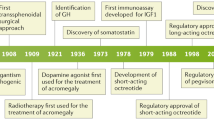Abstract
Background
Several classes of pharmacological agents are approved for the medical therapy of acromegaly, including dopamine agonists, somatostatin analogs and a growth hormone receptor antagonist. Pegvisomant, a growth hormone receptor antagonist, suppresses IGF-1 levels into the normal range in over ninety percent of patients. However, increased tumor volume was reported in patients receiving pegvisomant who had not received prior radiotherapy.
Objectives
To describe two patients with acromegaly who developed significant tumor enlargement on pegvisomant and discuss the potential mechanisms involved.
Intervention
Both patients received long-acting somatostatin analog (octreotide) therapy subsequent to incomplete transsphenoidal tumor resection. Octreotide did not normalize GH/IGF-1 levels in either patient but did control tumor mass size. Pegvisomant therapy was initiated after discontinuing octreotide.
Results
Both patients exhibited suppression of IGF-1 into the normal range during pegvisomant therapy. However, significant tumor enlargement occurred in both. Potential mechanisms for tumor enlargement include the natural tendency of the tumor to grow with time, discontinuation of tumor suppressive effects of the somatostatin analog, or a direct effect of pegvisomant. The presumed mechanism of tumor enlargement is by loss of the inhibitory effect on tumor growth when IGF-1 levels are reduced. This could also explain the increase in circulating GH levels in patients with acromegaly receiving pegvisomant; patient 1 demonstrated an 18–fold increase in circulating GH levels while receiving the drug.
Conclusions
The mechanisms of tumor enlargement in patients with acromegaly on pegvisomant are likely multifactorial. Patients, especially those who have not received prior radiotherapy, should be closely monitored for tumor enlargement.




Similar content being viewed by others
References
Newman CB (1999) Medical therapy for acromegaly. Med Clin North Am 28:171–190
Freda PU (2004) Somatostatin analogs in acromegaly. J Clin Endocrinol Metab 87:3013–3018
Van der Lely AJ, Hutson RK, Trainer PJ, Besser GM, Barkan AL, Katznelson L et al (2001) Long-term treatment of acromegaly with pegvisomant, a growth hormone receptor antagonist. Lancet 358:1754–1759
Van der Lely AJ, Muller AJ, Janssen JA, Davis RJ, Zib KA, Scarlett JA et al (2001) Control of tumor size and disease activity during cotreatment with octreotide and the growth hormone receptor antagonist pegvisomant in an acromegalic patient. J Clin Endocrinol Metab 86:478–481
Colao A, Pivonello R, Auriemma RS, De Martino MC, Bidlingmaier M, Briganti F et al (2006) Efficacy of 12-month treatment with the GH receptor antagonist pegvisomant in patients with acromegaly resistant to long-term, high-dose somatostatin analog treatment: effect on IGF-I levels, tumor mass, hypertension and glucose tolerance. Eur J Endocrinol 154:467–477
Di Chiro G, Nelson KB (1962) The volume of the sella turcica. Am J Roentgenol Radium Ther Nucl Med 87:989–1008
Resmini E, Dadati P, Ravetti JL, Zona G, Spaziante R, Saveanu A et al (2007) Rapid pituitary tumor shrinkage with dissociation between anti-proliferative and anti-secretory effects of a long-acting octreotide in an acromegalic patient. J Clin Endocrinol Metab e-pub Feb 20, 2007
Bevan JS (2005) The antitumoral effects of somatostatin analog therapy in acromegaly. J Clin Endocrinol Metab 90:1856–1863
Melmed S, Sternberg R, Cook D, Klibanski A, Chanson P, Bonert V et al (2005) A critical analysis of pituitary tumor shrinkage during primary medical therapy in acromegaly. J Clin Endocrinol Metab 90:4405–4410
Ezzat S, Snyder PJ, Young WF, Boyajy LD, Newman C, Klibanski A et al (1992) Octreotide treatment of acromegaly: a randomized, multicenter study. Ann Intern Med 117:711–718
Trainer PJ, Drake WM, Katznelson L, Freda PU, Herman-Bonert V, Van der Lely AJ et al (2000) Treatment of acromegaly with the growth hormone-receptor antagonist pegvisomant. N Engl J Med 342:1171–1177
Author information
Authors and Affiliations
Corresponding author
Rights and permissions
About this article
Cite this article
Frohman, L.A., Bonert, V. Pituitary tumor enlargement in two patients with acromegaly during pegvisomant therapy. Pituitary 10, 283–289 (2007). https://doi.org/10.1007/s11102-007-0042-x
Published:
Issue Date:
DOI: https://doi.org/10.1007/s11102-007-0042-x




